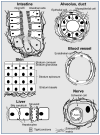Architecture in 3D cell culture: An essential feature for in vitro toxicology
- PMID: 28366709
- PMCID: PMC5623165
- DOI: 10.1016/j.tiv.2017.03.012
Architecture in 3D cell culture: An essential feature for in vitro toxicology
Abstract
Three-dimensional cell culture has the potential to revolutionize toxicology studies by allowing human-based reproduction of essential elements of organs. Beyond the study of toxicants on the most susceptible organs such as liver, kidney, skin, lung, gastrointestinal tract, testis, heart and brain, carcinogenesis research will also greatly benefit from 3D cell culture models representing any normal tissue. No tissue function can be suitably reproduced without the appropriate tissue architecture whether mimicking acini, ducts or tubes, sheets of cells or more complex cellular organizations like hepatic cords. In this review, we illustrate the fundamental characteristics of polarity that is an essential architectural feature of organs for which different 3D cell culture models are available for toxicology studies in vitro. The value of tissue polarity for the development of more accurate carcinogenesis studies is also exemplified, and the concept of using extracellular gradients of gaseous or chemical substances produced with microfluidics in 3D cell culture is discussed. Indeed such gradients-on-a-chip might bring unprecedented information to better determine permissible exposure levels. Finally, the impact of tissue architecture, established via cell-matrix interactions, on the cell nucleus is emphasized in light of the importance in toxicology of morphological and epigenetic alterations of this organelle.
Keywords: Basement membrane; Cell nucleus; Microfluidics; Organ-on-a-chip; Polarity; Tight junction.
Copyright © 2017 Elsevier Ltd. All rights reserved.
Conflict of interest statement
SAL reports potential conflicts of interest. There is no conflict of interest for SC and TK.
Figures


Similar articles
-
Human lung epithelial cell cultures for analysis of inhaled toxicants: Lessons learned and future directions.Toxicol In Vitro. 2018 Mar;47:137-146. doi: 10.1016/j.tiv.2017.11.005. Epub 2017 Nov 15. Toxicol In Vitro. 2018. PMID: 29155131 Review.
-
Experimental liver models: From cell culture techniques to microfluidic organs-on-chip.Liver Int. 2021 Aug;41(8):1744-1761. doi: 10.1111/liv.14942. Epub 2021 May 26. Liver Int. 2021. PMID: 33966344 Review.
-
From cells-on-a-chip to organs-on-a-chip: scaffolding materials for 3D cell culture in microfluidics.J Mater Chem B. 2020 Aug 12;8(31):6667-6685. doi: 10.1039/d0tb00718h. J Mater Chem B. 2020. PMID: 32567628 Review.
-
Three-dimensional (3D) cell culture studies: a review of the field of toxicology.Drug Chem Toxicol. 2023 May;46(3):523-533. doi: 10.1080/01480545.2022.2066114. Epub 2022 Apr 21. Drug Chem Toxicol. 2023. PMID: 35450503 Review.
-
21st Century Cell Culture for 21st Century Toxicology.Chem Res Toxicol. 2017 Jan 17;30(1):43-52. doi: 10.1021/acs.chemrestox.6b00269. Epub 2016 Dec 5. Chem Res Toxicol. 2017. PMID: 28092941 Free PMC article.
Cited by
-
Methods for fabrication and evaluation of a 3D microengineered model of myelinated peripheral nerve.J Neural Eng. 2018 Dec;15(6):064001. doi: 10.1088/1741-2552/aae129. Epub 2018 Sep 13. J Neural Eng. 2018. PMID: 30211687 Free PMC article.
-
Inclusion of cancer-associated fibroblasts in drug screening assays to evaluate pancreatic cancer resistance to therapeutic drugs.J Physiol Biochem. 2023 Feb;79(1):223-234. doi: 10.1007/s13105-021-00857-2. Epub 2021 Dec 5. J Physiol Biochem. 2023. PMID: 34865180 Free PMC article.
-
Advancements in Microfluidic Systems for the Study of Female Reproductive Biology.Endocrinology. 2021 Oct 1;162(10):bqab078. doi: 10.1210/endocr/bqab078. Endocrinology. 2021. PMID: 33852726 Free PMC article. Review.
-
3D bioprinting of complex tissues in vitro: state-of-the-art and future perspectives.Arch Toxicol. 2022 Mar;96(3):691-710. doi: 10.1007/s00204-021-03212-y. Epub 2022 Jan 10. Arch Toxicol. 2022. PMID: 35006284 Free PMC article. Review.
-
Application of Graphene in Tissue Engineering of the Nervous System.Int J Mol Sci. 2021 Dec 21;23(1):33. doi: 10.3390/ijms23010033. Int J Mol Sci. 2021. PMID: 35008456 Free PMC article. Review.
References
Publication types
MeSH terms
Grants and funding
LinkOut - more resources
Full Text Sources
Other Literature Sources
Molecular Biology Databases

